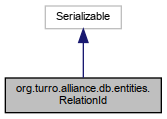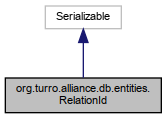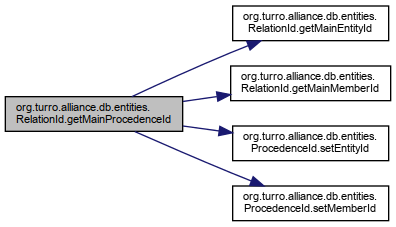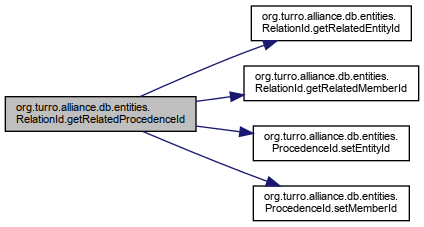- Author
- Lluis Turró Cutiller lluis.nosp@m.@tur.nosp@m.ro.or.nosp@m.g
Definition at line 35 of file RelationId.java.
◆ equals()
| boolean org.turro.alliance.db.entities.RelationId.equals |
( |
Object |
obj | ) |
|
Definition at line 124 of file RelationId.java.
131 if (getClass() != obj.getClass()) {
134 final RelationId other = (RelationId) obj;
135 if (!Objects.equals(
this.mainEntityId, other.mainEntityId)) {
138 if (!Objects.equals(
this.relatedEntityId, other.relatedEntityId)) {
141 if (!Objects.equals(
this.mainMemberId, other.mainMemberId)) {
144 return Objects.equals(this.relatedMemberId, other.relatedMemberId);
◆ getMainEntityId()
| String org.turro.alliance.db.entities.RelationId.getMainEntityId |
( |
| ) |
|
◆ getMainMemberId()
| Long org.turro.alliance.db.entities.RelationId.getMainMemberId |
( |
| ) |
|
◆ getMainProcedenceId()
| ProcedenceId org.turro.alliance.db.entities.RelationId.getMainProcedenceId |
( |
| ) |
|
Definition at line 91 of file RelationId.java.
92 ProcedenceId mainId =
new ProcedenceId();
◆ getMember()
| WsMember org.turro.alliance.db.entities.RelationId.getMember |
( |
| ) |
|
Definition at line 105 of file RelationId.java.
106 return Clients.getMember(mainMemberId);
◆ getRelatedEntityId()
| String org.turro.alliance.db.entities.RelationId.getRelatedEntityId |
( |
| ) |
|
◆ getRelatedMember()
| WsMember org.turro.alliance.db.entities.RelationId.getRelatedMember |
( |
| ) |
|
Definition at line 109 of file RelationId.java.
110 return Clients.getMember(relatedMemberId);
◆ getRelatedMemberId()
| Long org.turro.alliance.db.entities.RelationId.getRelatedMemberId |
( |
| ) |
|
◆ getRelatedProcedenceId()
| ProcedenceId org.turro.alliance.db.entities.RelationId.getRelatedProcedenceId |
( |
| ) |
|
Definition at line 98 of file RelationId.java.
99 ProcedenceId relatedId =
new ProcedenceId();
Long getRelatedMemberId()
String getRelatedEntityId()
◆ hashCode()
| int org.turro.alliance.db.entities.RelationId.hashCode |
( |
| ) |
|
Definition at line 114 of file RelationId.java.
116 hash = 79 * hash + Objects.hashCode(this.mainEntityId);
117 hash = 79 * hash + Objects.hashCode(this.mainMemberId);
118 hash = 79 * hash + Objects.hashCode(this.relatedEntityId);
119 hash = 79 * hash + Objects.hashCode(this.relatedMemberId);
◆ isEmpty()
| boolean org.turro.alliance.db.entities.RelationId.isEmpty |
( |
| ) |
|
Definition at line 86 of file RelationId.java.
87 return Strings.isBlank(mainEntityId) || Zero.orNull(mainMemberId) ||
88 Strings.isBlank(relatedEntityId) || Zero.orNull(relatedMemberId);
◆ setMainEntityId() [1/2]
| void org.turro.alliance.db.entities.RelationId.setMainEntityId |
( |
Long |
mainEntityId | ) |
|
Definition at line 76 of file RelationId.java.
77 this.mainEntityId = Converter.STANDARD.convert(mainEntityId, String.class);
◆ setMainEntityId() [2/2]
| void org.turro.alliance.db.entities.RelationId.setMainEntityId |
( |
String |
mainEntityId | ) |
|
◆ setMainMemberId()
| void org.turro.alliance.db.entities.RelationId.setMainMemberId |
( |
Long |
mainMemberId | ) |
|
◆ setRelatedEntityId() [1/2]
| void org.turro.alliance.db.entities.RelationId.setRelatedEntityId |
( |
Long |
relatedEntityId | ) |
|
Definition at line 80 of file RelationId.java.
81 this.relatedEntityId = Converter.STANDARD.convert(relatedEntityId, String.class);
◆ setRelatedEntityId() [2/2]
| void org.turro.alliance.db.entities.RelationId.setRelatedEntityId |
( |
String |
relatedEntityId | ) |
|
Definition at line 62 of file RelationId.java.
63 this.relatedEntityId = relatedEntityId;
◆ setRelatedMemberId()
| void org.turro.alliance.db.entities.RelationId.setRelatedMemberId |
( |
Long |
relatedMemberId | ) |
|
Definition at line 70 of file RelationId.java.
71 this.relatedMemberId = relatedMemberId;
The documentation for this class was generated from the following file:





